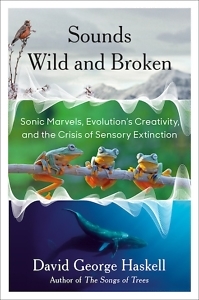Call of the Wild
David George Haskell explores all things acoustic within the natural world
FROM THE CHAPTER 16 ARCHIVE: Sounds Wild and Broken was recently selected as a finalist for the 2023 Pulitzer Prize in general nonfiction. This review originally appeared on February 22, 2022.
***
“Sound is ephemeral,” writes David George Haskell, a professor of biology and environmental studies at the University of South, in his preface to Sounds Wild and Broken: Sonic Marvels, Evolution’s Creativity, and the Crisis of Sensory Extinction. “Yet in its passage, sound links living beings and wakes the latent powers of biological and cultural evolution. These generative powers, acting over hundreds of millions of years, produced the astonishingly diverse sounds of the living Earth.”

Over the next 400-plus pages, Haskell introduces readers to almost all of them, diving deep into the evolutionary physics of natural sound, from bacteria to crickets, dinosaurs to birds, whales to humans, and pretty much every creature that ever swam, walked, or flew. Beyond the tales he coaxes from widely varied creatures and their noisemaking instruments, Haskell devotes much discussion to unnatural sound: the diverse cultural and physical history of human music; the cacophony of noise pollution in cities and oceans; human-wielded banshee saws destroying rainforests, filling their spaces with silence. (In his acknowledgments, the author pledges half of this book’s net profits will go to organizations fighting to ease the “acoustic crises” he documents.)
Haskell’s celebrated first book, The Forest Unseen, published in 2012 and a finalist for both a Pulitzer Prize and PEN/E.O. Wilson Literary Science Writing Award, focused on a small circle of forest (just over a meter) on the Cumberland Plateau near his home in Sewanee. His second, The Songs of Trees in 2017, circled the globe, each chapter alighting on a specific tree to explain evolution, sounds, and the interconnectedness of living things.
The structure of Sounds Wild and Broken is more ambitious still, covering nearly all life throughout and beyond the history of Earth, reaching into the Big Bang and harmonic waves of creation rippling through galaxies — a physicist’s rendering of the music of the spheres. All the while, Haskell enumerates global threats civilization imposes on our natural environment and its vanishing soundscape.
 Yet the book is neither a natural encyclopedia nor an impassioned conservationist’s appeal — at least, not so you’d notice on any given page. Rather, Haskell creates a pleasing poetry of nature, his carefully crafted sentences luring readers in for the long haul. Open the book to any page, let your eyes fall on a paragraph, and the feeling is akin to walking the halls of a large university and hearing a professor speak with such passion and knowledge about some otherwise obscure topic that you wander through the open door and take a seat in the last row. Before you know it, hours have passed.
Yet the book is neither a natural encyclopedia nor an impassioned conservationist’s appeal — at least, not so you’d notice on any given page. Rather, Haskell creates a pleasing poetry of nature, his carefully crafted sentences luring readers in for the long haul. Open the book to any page, let your eyes fall on a paragraph, and the feeling is akin to walking the halls of a large university and hearing a professor speak with such passion and knowledge about some otherwise obscure topic that you wander through the open door and take a seat in the last row. Before you know it, hours have passed.
As Haskell points out, writing is itself a cultural and evolutionary consequence of sound. After explaining how the calls of bats and whales fire the regions of their brains “concerned with memory, analysis, and production of sound,” he notes:
In reading these words, you take this human talent for integration one step further. Black-and-white glyphs are crystallizations of what was, until the invention of written language, ephemeral. Breath turned to ink. Vibrations in air frozen onto the page.
Reading ignites the brain centers associated with listening, Haskell explains, such that we cannot help but “hear” writing in our head. The physical details of this process might become technical and muddy in the hands of a lesser writer, but Haskell’s voice fills the reader’s auditory pathways with echoes of Wordsworth and Tennyson. Whether describing the human brain or the ways different conifer forests change the voices and crooked beaks of red crossbills in Colorado, compared to those in Washington, Haskell speaks a celebratory poetry of nature. At times it may resemble the cadence familiar to modern ears from the wildlife documentaries of Sir David Attenborough, but Haskell’s voice is unique in contemporary nature writing.
“The Earth’s sounds matter in part because they are ephemeral manifestations of order and narrative,” he writes near the end of the book. The same might be said of the glorious music of Sounds Wild and Broken.

Michael Ray Taylor is the author of Hidden Nature: Wild Southern Caves. He teaches at Henderson State University in Arkadelphia, Arkansas.


